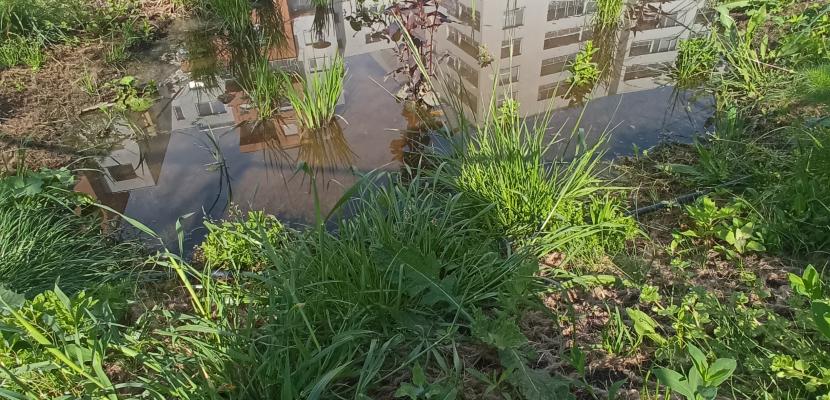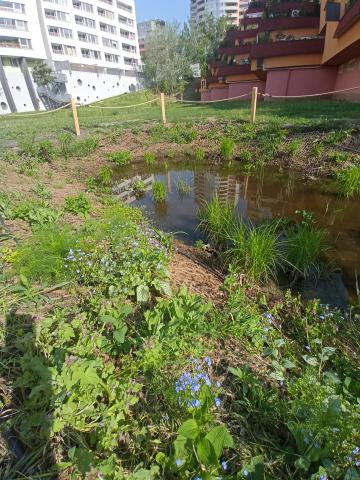
“Sponge” public open space Kaskady

About this good practice
Bratislava Municipality Karlova Ves pursued a pilot programme to implement the benefits of using green and grey infrastructure to tackle floods and summer droughts. In the open space of the inner courtyard of the residential complex Kaskady, they implemented sustainable drainage systems (SUDs) to capture and use rainwater and slow and enable to infiltrate the water runoff. The rainwater from the roofs and terraces of the residential buildings is drained into two underground tanks (7m3 volume each). The captured rainwater is then used as drop irrigation of newly planted trees trees (21), shrubs (84) and perennial plants.
Two wetland areas have been created, where the rainwater overflow from the underground tanks is situated; seven raingarden infiltration areas have been created, as well as 2 infiltration swales. These infiltration areas are created as flowering meadows with variety of blooming species favourable for pollinators which are outstanding at promoting biodiversity and providing habitats for different species. The moisture that gradually evaporates from wetland and rentention areas will positively influence the microclimate especially during hot summer days. The main stakeholders and beneficiaries are the inhabitants of the surrouding residential buildings, using regularly this open space of the inner courtyard.
Expert opinion
Cities have been facing many environmental pressures, including climate change, pollution and waste. Green infrastructure in urban areas takes the form of vegetated green surfaces, such as parks, trees, grasslands, but also private gardens. These all work together to support biodiversity, pollinators, carbon sequestration, flood protection and protection against excessive heat. Moreover, green infrastructure positively impacts human health and wellbeing. Green infrastructure is an important element in fulfilling EU legislation, especially in the areas of biodiversity conservation and climate change mitigation and adaptation. Namely, it falls under the EU Biodiversity strategy for 2030 as part of the European Green Deal. The aforementioned benefits are also at work in this good practice, where the city of Bratislava has created a smart water management method, by building sustainable drainage systems (SUDs) to capture and use rainwater, enable infiltrating the water runoff, while cooling the city in warm summers. The resulting wetland areas are biodiversity and pollinator hotspots. The example can inspire other cities and help them implement a smart nature-based solution.
Resources needed
The total costs including the detailed design documentation (blue prints) and the realisation work were 72 750€. The municipality combined financial resources from INTERREG Europe (project Perfect), LIFE (project DELIVER) and EEA grants (project MitAdapt) to secure the financing of the best practice
Evidence of success
The municipality tested different solutions to tackle climate change through green infrastructure. This new system of raingardens, infiltration swales, underground tanks with irrigation system is creating a sponge landscape where rainwater is managed and repurposed in the local area. Based on the municipalities’ calculations, 100% of the rainwater fallen in the inner courtyard will be used or infiltrated, which represent the volume 5 069 68 m3 of rainwater yearly.
Potential for learning or transfer
The practice is fully transferable and can be transfered with adequate resources, existing relevant backgound documents and the strong motivation and cooperation of different actors (building manager, inhabitants and owners of the surrounding flats)
Further information
Images

